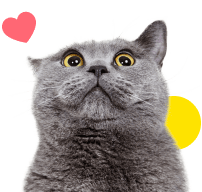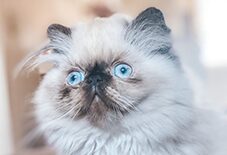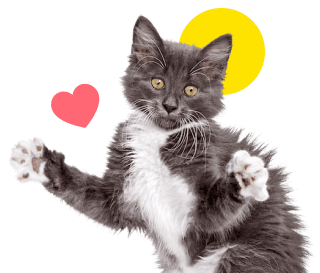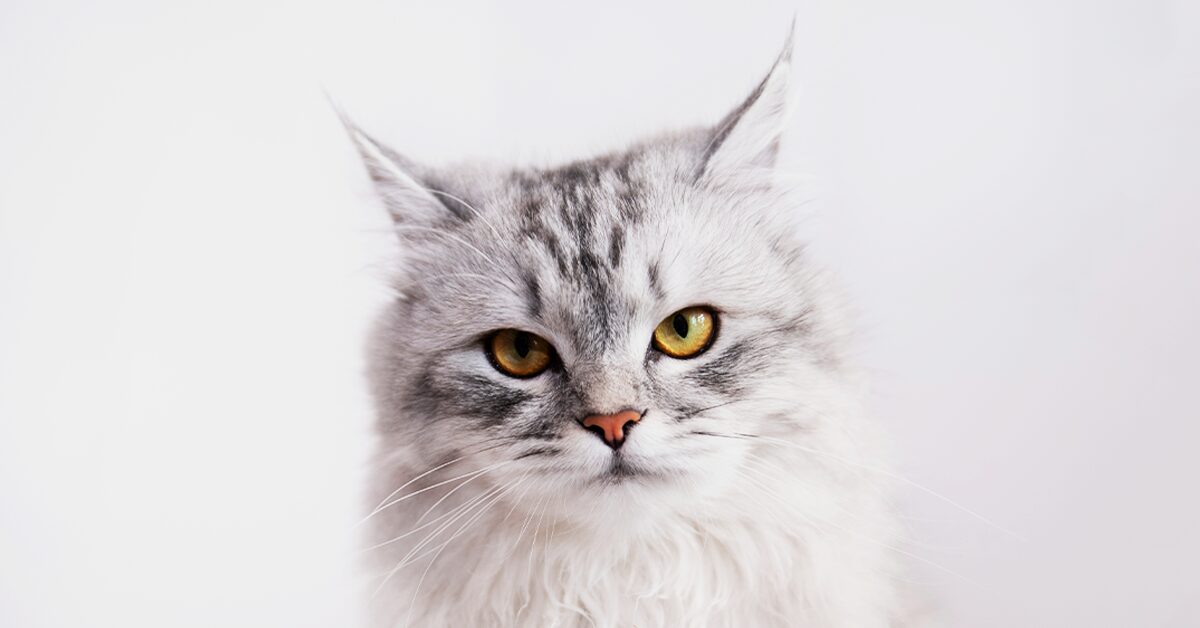
Meet the Persian
Best Fur Friend
Feline Chic
Best Couch Cuddler
If you’re looking for a low-maintenance kitty with high-maintenance looks, I’m the breed for you! First things first: I’m a world-class beauty, but I don’t just wake up like this. I shed A LOT and need daily combing to keep my lustrous locks looking their best. I’m easygoing and sweet-tempered but do better in a home with no hyper little kids or pets (I’m chill and need my surroundings to be the same way). I’m loyal and affectionate but I’m totally not clingy. I do my own thing and love to lounge around but I’d always rather be on your lap.
Some humans mistake me for lazy but I’m basically royalty, so any spot around the house I pick to luxuriate in is my throne. I have a soft melodic voice to match my elegant looks, and I’m not very chatty (I prefer to communicate with my big round eyes). I’m not high energy but I love spending time with my humans so interactive toys are my favs for playtime. Even though my glam takes work, humans think I’m worth it – I’m the 4th most popular cat breed!
Ready to learn more about me? Let’s dig in.
Ready to learn more about me? Let’s dig in.
 My Many Looks
My Many Looks
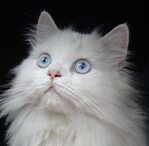
White
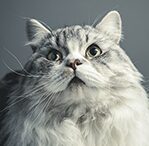
Silver
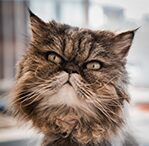
Brown Tabby
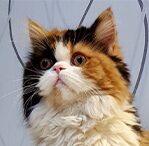
Tortoiseshell
 My Breed Characteristics
My Breed Characteristics
 Furbulous Fact
Furbulous Fact
We Persians have many looks when it comes to our coat colors and patterns and our eye color, but we also can have different style faces! Doll face (aka traditional) Persians have more pointed features, where peke-face Persians have the more iconic flat face and snub nose look. Peke-face Persians are preferred for cat shows, while doll face Persians are more commonly seen on the couch than in the show ring. No matter what face a Persian has, they will always have a round head, chubby cheeks, and a cobby (short and thick) body.
 As I Grow Up
As I Grow Up
As you can see, we Persians age pretty gracefully. Here are a few key milestones in my growth & development to be aware of as I grow up from a kitten to an adult and senior!
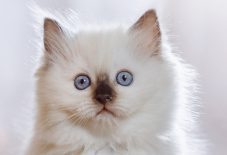
Kitten3-6 Months
I’m going to need a lot of grooming, so get me used to combing and baths early on – I’ll love the attention, and treats always help!
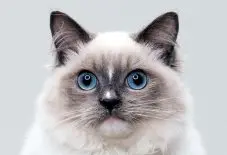
Adult1-2 Years
I’m all grown up! I’m not an active breed, so I need my human to keep an eye on my weight so I don’t get too chunky.
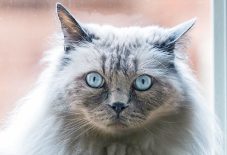
Senior9-10 Years
This is a great time for my human to start taking me for twice yearly checkups, including blood work to screen for my breed’s potential kidney problems.
 History of My Breed
History of My Breed
We Persians are a very old breed, although the humans don’t know exactly how we came to be. They believe my earliest ancestors came from modern-day Iran (aka Persia, which is where my breed gets its name!) and from Turkey. Today’s Persians and our beautiful cousins, Turkish Angoras, are both believed to be related to these early longhaired cats. One human, an Italian composer named Pietro Della Valle, absolutely loved to travel the world, and during his travels to Iran (then Persia), some of my ancestors caught his eye. In 1620, he brought several of these longhaired gray beauties back to Europe with him.
We Persians were kings and queens on the scene as early as the world’s first cat show at London’s Crystal Palace in 1871 and we’ve been reigning supreme ever since. Our regal beauty even caught the eye of Britain’s Queen Victoria herself! The Queen had two furbulous Blue Persians, which made us a popular breed among European aristocrats. When we first came to North America in the late 1800s, we were a huge hit. We even replaced the Maine Coon as America’s favorite longhaired feline!
We were already hugely popular in America by the time we were recognized by the Cat Fanciers’ Association when it was founded in 1906. We even hit the big screen when Hollywood decided to choose one of us – a gorgeous white Persian – to star in the 1963 James Bond movie From Russia With Love. The “James Bond cat” became iconic and made sure all of America knew we Persians are superstars. Our gorgeous looks and charming personalities make sure that we never fall out of fashion – today we are the CFA’s 4th most popular breed!
 Pawesome Cats to Parent
Pawesome Cats to Parent
In addition to purebred Persians like me, there are tons of prrrfectly sweet mixed-breed Persians that are looking to find their furever homes. You can learn where to find your next pet below!
 Care Tips
from Dr. Joanna Woodnutt, MRCVS
Care Tips
from Dr. Joanna Woodnutt, MRCVS 
Watch your Persian for signs of breathing trouble.
Persians are unusual for cats in that they're brachycephalic (short-nosed or flat-faced). This means they're prone to problems with their breathing. Owners of Persian cats should be aware of signs of Brachycephalic Obstructive Airway Syndrome (BOAS) – such as breathing through the mouth, snoring, and sleeping with the head propped up on things – that may mean the cat needs surgery to improve their airflow.
Consider getting a DNA test for your new pet.
Persians are genetically predisposed to polycystic kidney disease. Polycystic kidney disease affects one in three Persians, and it is a progressive disease for which there is no cure. Breeding cats should either have a genetic test or an ultrasound scan to confirm that they are free of the disease before breeding, and kittens should only be bought from parents that have undergone these health tests.
Prepare for lots of at-home and professional grooming.
Persian cats have long coats that are very dense, and they need regular grooming. They will need to be introduced to grooming as kittens so they can get used to it. Even with a daily brush, these cats will often need to visit a professional groomer or a vet to have matted hair clipped out. If matting is severe, they may need to be sedated for grooming.
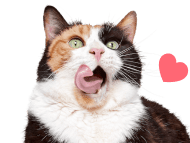
 Why Get Cat Insurance?
from Pumpkin®
Why Get Cat Insurance?
from Pumpkin®
While Persians are a generally healthy breed, cat-astrophes can happen to any cat at any age. If your kitty gets hurt or sick, pet insurance can help you say ‘yes’ to the best care, even when it’s costly. When it comes to shopping for this breed, you’ll want to choose an insurance plan like Pumpkin plan that covers hereditary conditions Persians are prone to developing, and that can be costly to treat. While a reputable breeder will conduct genetic testing on your kitty’s parents to help minimize the chances of passing down hereditary conditions, they can’t always be avoided. Let’s look at some common ones, and how Pumpkin Cat Insurance plans could help cover the cost of care!
 Heart Disease
Heart Disease
Persians may develop heart problems, specifically Hypertrophic Cardiomyopathy (HCM). In this condition, the muscle walls of the heart thicken causing a decline in cardiac function. While there is no cure, heart disease can be managed with medication and dietary changes.
- Cost to Treat
- $500-$3,000 (surgical)
- Pumpkin Pays Back*
- $450-$2,700
 Bladder Stones
Bladder Stones
Persians are prone to developing urinary tract problems, including bladder stones. This condition occurs when minerals build up and form stones that make urination extremely painful to impossible, depending on their size. While smaller stones can be removed via catheter, larger stones must be surgically removed.
- Cost to Treat
- $500-$3,500
- Pumpkin Pays Back*
- $450-$3,150
 Brachycephalic Syndrome
Brachycephalic Syndrome
Persians are a brachycephalic (flat-faced) breed. The anatomy of their head, nose, and throat makes it difficult to breathe. Persians with severe Brachycephalic Syndrome may require several surgeries, including soft palate resection and stenotic nares resection. Surgeries are not a forever fix, and these cats may need additional treatment.
- Cost to Treat
- $500-$2,000 (surgical)
- Pumpkin Pays Back*
- $450-$1,800
 Cherry Eye
Cherry Eye
As a brachycephalic breed, Persians are prone to cherry eye. This condition occurs when the third eyelid (nictitating membrane) becomes displaced. It is characterized by a red or pink swollen mass in one or both eyes. There are non-surgical and surgical options to correct cherry eye depending on the severity of the problem.
- Cost to Treat
- $1,200 to $1,600 (surgical)
- Pumpkin Pays Back*
- $1,080-$1,440
*Sample shows 90% reimbursement of covered vet bill assuming $250 annual deductible has been met.
